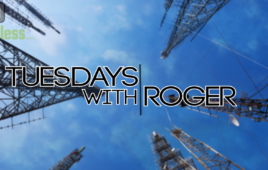Attendees at this year’s CCA conference in Fort Lauderdale were treated to a detailed overview of the upcoming FCC incentive auction courtesy of Trey Hanbury and Tom Peters of the law firm Hogan Lovells. If you want to make it out alive come bidding time in March, here’s what you need to know:
Auction Basics
The incentive auction will include three basic stages. First, the FCC will inventory the available spectrum. This inventory will include open spectrum and open spectrum from broadcasters who are potentially interested in selling their section of the airwaves. Broadcasters may put their licenses into play to see how much money they might fetch, but it doesn’t necessarily mean they’re going to sell.
In the second stage, the FCC will price out the available spectrum in a reverse bidding process to see how much broadcasters are demanding for their swaths of spectrum. Prices will start high and will decrease round by round.
In the third stage, the FCC will hold a forward auction in which wireless providers will bid against one another to acquire the newly available spectrum. These prices will start low and raise in subsequent rounds.
Auction Blocks and Licenses
The incentive auction may include as many as 12 blocks or as few as two in one of eleven different band plans, depending on the amount of spectrum available and demand.
The FCC has designated 416 different geographical areas within the United States and will sell multiple licenses in each area. Licenses will be sold in 5+5MHz sets, that is, 10 MHz chunks that include 5 MHz for uplink and 5 MHz for downlink.
The commission has designated two different categories of licenses: Category 1 and Category 2. Category 1 licenses can have anywhere from 0 to 15 percent impairment – or interference from television stations assigned within the 600 MHz band – while Category 2 licenses may have anywhere from 15 to 50 percent impairment. Licenses with more than 50 percent impairment will not be auctioned. An estimated 93 percent of licenses will fall under Category 1.
Impairments
Impairments will exist because the FCC took a compromise approach and sought the band plan that works in the most location across the country.
Therefore, impairments may occur in certain markets, particularly in highly profitable markets such as New York City or Los Angeles, as well as along the country’s border areas, Hanbury said. The largest number of impairments that occur nationwide will occur with the initial band plan offered, and they will either stay the same or go down as bidding moves the band plan to lower and lower stages.
The FCC has introduced a discount for impaired licenses at a rate of 1 percent for every 1 percent impairment on that license.
Spectrum Reserve
The most interesting aspect about the spectrum reserve is that it won’t technically exist at the start of the auction – that is, until the potential revenue from the auction exceeds what the broadcasters are demanding. The reserve also has the potential to diminish or disappear completely during the auction process depending on demand.
“It is a market-based, contingent reserve,” Hanbury explained. “It does not even exist until we’re at the final stage of the auction. It’s not as if the FCC will start the auction with the reserve in place. They will not. Everyone’s going to be in a common pool of demand and you’ll be competing head to head with Verizon and AT&T. But once we have the reserve triggered…Verizon and AT&T, if their low band spectrum holdings exceed one third of the low band available, will have to relocate their demand from the reserve blocks to the non-reserve blocks. ”
When the spectrum reserve comes into play, the size of the reserve will depend on which band plan the FCC lands on. The reserve may include as much as 30 MHz or as little as 10 MHz. Any band plan over 84 MHz should include 30 MHz of reserve. If there is less than 70 MHz of broadband available the reserve will be less.
The reserve will also depend on the demand expressed for the reserve by reserve eligible bidders. If no bids are placed for the spectrum reserve, it will become non-reserve spectrum.
“The reserve will collapse, almost to zero potentially if nobody bids for it,” Hanbury explained. “So if there’s insufficient demand that reserve will become available on the non-reserve side to Verizon, AT&T and anyone else.”
Bidding
It is important to note that operators will be bidding in quantity of licenses rather than by price, though bids will include the price participants are willing to pay for each of those licenses. If a bid is placed for zero licenses at a certain price, Peters said it means a bidder has reached the “point of indifference” where they will take one or zero licenses at that price but none at a higher cost.
Two types of bidders in the incentive auction – small businesses and rural service providers – will be able to receive special bidding credits. Small businesses will be eligible to receive a discount of either 15 percent or 25 percent, while rural carriers with less than 250,000 subscribers will be eligible for a 15 percent discount. These credits cannot be combined. The discounts will apply in both the license bidding and block assignment rounds.
Bidders have been warned by the FCC to follow strict anti-collusion rules or else be faced with fines or license forfeitures. A “quiet period” will run from the filing of applications to the assignment of licenses. According to the FCC’s rules, bidders may not communicate about “bids or bidding strategy” in regard to licenses at issue in the auction. There will be a webinar on October 28, 2015 at 1:30 EST on competitive bidding rules.
Winners
When the auction is completed, the FCC will have a list of winners but not block assignments.
In assigning spectrum blocks, the FCC will first try to ensure that winners of multiple blocks receive contiguous assignments before auctioning off the remaining unassigned blocks in a sealed, single-bid auction round. The auction will be a second-price auction, in which the highest bidder is the winner but only pays the second highest bid price. For example, if Company A bids $100 for an auction block and Company B bids $10, Company A wins the assignment at a cost of only $10. If the FCC’s contiguity rules account for all possible block assignments, assignment bidding will not occur.
The United States has never before conducted an assignment auction, but the process as conducted in other countries has typically accounted for one to two percent of auction revenues.
Winners of the incentive auction will be subject to buildout requirements set by the FCC that dictate the carriers must provide coverage to 40 percent of the population within their license area (based on the unimpaired population figures) within six years and 75 percent of the population within 12 years. The buildout clock will start from the time of license assignments.
Further FCC guidance on the incentive auction is expected to be released in a Public Notice around Columbus Day.
Filed Under: Telecommunications (spectrums)




